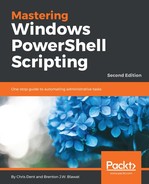The Microsoft Windows operating system, especially the most recent versions, comes with a wide variety of modules preinstalled. These, as well as any other modules that have been installed, can be viewed using the Get-Module command.
By default, Get-Module shows modules that have been imported (either automatically or using Import-Module); for example, if the command is run from PowerShell ISE, it will show that the ISE module has been loaded:
PS> Get-Module
ModuleType Version Name ExportedCommands
---------- ------- ---- ----------------
Script 1.0.0.0 ISE {Get-
IseSnippet...}
Manifest 3.1.0.0 Microsoft.PowerShell.Management {Add-
Computer...}
Manifest 3.1.0.0 Microsoft.PowerShell.Utility {Add-Member...}
The ListAvailable parameter shows a complete list of modules:
Get-Module -ListAvailable
Modules are listed here if they are found under any of the paths in the %PSMODULEPATH% environment variable. The variable contains the following paths:
PS> $env:PSModulePath -split ';'
C:UserswhoamiDocumentsWindowsPowerShellModules
C:WINDOWSsystem32WindowsPowerShellv1.0Modules
C:Program FilesWindowsPowerShellModules
Additional paths to search may be added to the %PSMODULEPATH% variable if required.
Modules may exist in more than one location. Get-Module (and Import-Module) will consider each path in order so that if a matching module is found, the search stops (even if a newer version exists in a different directory).
The %PSModulePath% environment variable is made up of user-level and machine-level settings. The value held in $env:PSMODULEPATH is the result of merging the two values (values from user followed by values from the machine).
Get-Module can show each instance of a module regardless of the path using the All parameter:
Get-Module <ModuleName> -All -ListAvailable
